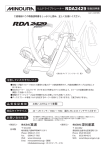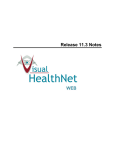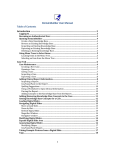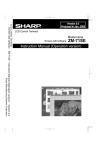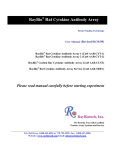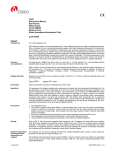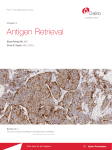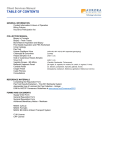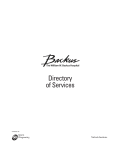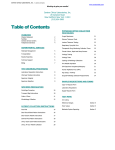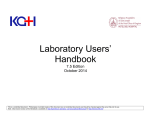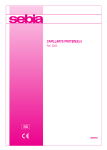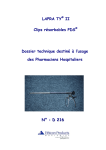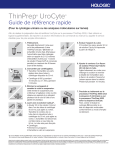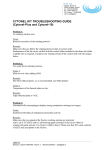Download THE DELTA PATHOLOGY GROUP, L.L.C. Service Manual Patient
Transcript
THE DELTA PATHOLOGY GROUP, L.L.C. Service Manual Patient Preparation Specimen Collection Labeling Fixation Handling Transportation Table of Contents Content Page # Contact Information Directory Diplomats American Board of Pathology Medical Staff Scope of Services Quality Control & Assurance Practice Notice of Privacy Practices Client Instructions for Completing Requisition Client Specimen & Slide Labeling Requirements Client Submission Requirements (referral and overnight) Surgical Pathology Non-Gynecological Cytology Gynecological Cytology Flow Cyometry Specialty Testing Stains Molecular and Cytogenetics 2 3 5 6 7 8 9 10-16 17-18 19 20 21-26 27-33 34-43 44-49 50-55 56-59 Contact Information: Client Services: Location Shreveport Shreveport Alexandria Alexandria Monroe Lafayette Lafayette Crowley Address 2915 Missouri One St. Mary Place 211 Fourth St. 3330 Masonic Drive 309 Jackson Street 611 Landry Street 4600 Ambassador Caffery 1307 Crowley Rayne Hwy., Suite D Phone 318-621-8820 318-681-4471 318-796-3180 318-561-4154 318-966-4105 337-289-4383 337-521-9363 337-783-3159 All Locations: Delta Pathology Group, LLC 2915 Missouri St. Shreveport, La 71109 Delta Pathology Group, LLC @Christus Schumpert One St. Mary Place, Shreveport, La 71101 Delta Pathology Group, LLC @ WK Bossier Delta Pathology Group, LLC @ Shreveport 2400 Hospital Drive, Suite 130 Bossier, La. Surgery 71111 745 Olive Street, Shreveport, La. 71104 Delta Pathology Group, LLC @ Rapides Delta Pathology Group, LLC @ St. Francis Regional Cabrini 211 Fourth St., Box 30113, Alexandria, La. 3330 Masonic Dr., Alexandria, La. 71310 71301 Delta Pathology Group, LLC @ St. Francis Delta Pathology Group, LLC @ St. Francis Medical North Hospital 3421 Medical Park Dr., 309 Jackson St.., Monroe, La. 71201 Monroe, La. 71203 Delta Pathology Group, LLC @ Our Lady Delta Pathology Group, LLC @ Women’s of Lourdes and Children Hospital, 4600 Ambassador 611 St. Landry St., Lafayette, La. 70506 Caffrey, Lafayette, La70508 Delta Pathology Group, L.L.C @ Crowley 1307 Crowley Rayne Hwy., Suite D Crowley, La. 70526 Supply Orders/Fax Supply Orders: Fax All Orders: 318-621-0108 Phone All Orders: 364-2087 or 1-800-530-5088 Web: www.deltapathology.com www.deltamdx.com 3 Laboratory Directory Medical Staff Scope of Services Quality Assurance Privacy Practices Authorization for Release Completing a Requisition Specimen and Slide Labeling Referral Testing Submission of Specimens Stains and Specialty Testing 4 Directory COLLEGE OF AMERICAN PATHOLOGISTS ACCREDITED CAP # 20113-02 CLIA # 19D0463379 CAP # 20101-01 CLIA # 19D0664460 CAP # 7199493 CLIA # 19D1070597 CAP # 7225076 CLIA # 19D1099427 CAP # 20144-04 CLIA # 19D0935738 CAP # 7523234-01 CLIA # 19D2014888 CAP # 7204273 CLIA #19D1075141 CAP # 7204312 CLIA #19D1075143 CAP # 7520585 CLIA # 19D2010173 CAP # 7524918 CLIA # 19D2014889 N/A CLIA# 19D1073946 2915 Missouri Ave Shreveport, La. 71109 One St. Mary Place Shreveport, La. 71101 WK Bossier Health Center 2400 Hospital Dr., Suite 130 Bossier, La. 71111 Shreveport Surgery Center 745 Olive St. Shreveport, La. 71104 211 4TH St. Box 30113 Alexandria, La. 71301 3330 Masonic Drive Alexandria, La 71301 309 Jackson St. Monroe, La. 71210 3421 Medical Park Dr. Monroe, La. 71203 611 St. Landry St. Lafayette, La. 70506 4600 Ambassador Caffrey Lafayette, La. 70508 1307 Crowley Raine Hwy. Suite D. Crowley, La. 70526 After Hours and Weekends: Contact the respective hospital laboratory for the pathologist on-call or call the respective hospital for assistance. The pathologist on call will be paged. For your convenience location numbers are listed (see page three). 5 Diplomats American Board of Pathology William N. Ball, Jr., M.D., FCAP Carrie L. Bearden, M.D., FCAP Richard J. Blanchard, Jr., M.D., FCAP Stephen P. Blanchard, M.D., FCAP M’Liss Crosier, M.D., FCAP William Eggers, M.D., FCAP Bruce Gray, M.D., FCAP Janis Gulick, M.D., FCAP James Hair, M.D., FCAP Stephanie Hanson, M.D., FCAP G. Kenneth Harrison, M.D., FCAP J. Steven Heard, M.D., FCAP Bruce Herrington, M.D., FCAP Vivek K. Khare, M.D., FCAP J. Anthony Lee, M.D., FCAP William Liles, M.D., FCAP Joan Marshak, M.D., FCAP Bernadette McLaren, M.D., FCAP Michael Miguez, M.D., FCAP Sudha G. Pillarisetti, M.D., FCAP Ronald N. Padgett, M.D., FCAP Louis J. Sardenga, M.D., FCAP F. Thomas Siskron, III, M.D., FCAP Gregory Wellman, M.D., FCAP David J. Werner, M.D., FCAP W. Allen Wesche, M.D., FCAP R. Bruce Williams, M.D., FCAP 6 Medical Staff The Delta Pathology Group, L.L.C., is an independent pathology group with services and laboratories in North, Central and South Louisiana. The group is comprised of a staff of twenty-seven pathologists with boards in anatomic and clinical pathology. Specialties represented in the group include, Dermatopathology, Cytopathology, Hematopathology, and Pediatric Pathology, providing extensive diagnostic abilities for clinicians and patients. The molecular diagnostics and cytogenetics divisions extend the diagnostic ability of the group to provide timely diagnostic services for improved patient care. The Delta Pathology Group, L.L.C. provides services for over forty hospitals. The pathologists serve as Laboratory Directors and provide twenty-four hour coverage for the needs of staff, physicians, and patients. The Delta Pathology Group, L.L. C. participates in the College of American Pathologists accreditation program and also serve as inspectors for other laboratories through the CAP peer review program. 7 Scope of Services Diagnostic Services and Consultation Anatomic and clinical pathology Full service anatomic pathology laboratory serving local and regional clients Advanced testing methodologies available in-house Rapid test reporting through our electronic reporting system Rapid turn around time of test results Anatomic Pathology Service Breast Pathology Cytopathology, including thin layer technology Dermatopathology Gastrointestinal Pathology Genitourinary Pathology Gynecologic Pathology Hematopathology Pediatric Pathology Surgical Pathology Veterinary Pathology Flow Cytometry Service Immunohistochemistry and FISH Technology Molecular & Cytogenetic testing Support Service Consultative Services through Pathology Resource Network, L.L.C. o Administrative Consultation o Management o Compliance Service o Billing Services o Accounting /Payroll o Human Resources Stat Service Courier Representative Client Service Client Representative Pathologist availability 24/7 Laboratory Directorship Information Technology Connectivity EMR Web Portal 8 Quality Control and Quality Assurance Practice Anatomic Pathology: I. Quality Assessment Random review of all surgical pathology diagnoses. 100% review of all frozen section diagnoses. 100% review of consultations from outside sources. II. Daily intradepartmental consultations. III. Clinical information and previous test results are compared with the current testing for internal quality assurance. IV. Pathologists participate in the College of American Pathologists Performance Improvement Program (PIP) and Q-Probes. Cytology: I. The quality control rescreen of negative PAP smears exceeding the CLIA mandated minimum of 10%. I. Continuous monitoring of cytotechnologists’ performance with appropriate remedial actions including reassessment of workload limits and focused quality control procedures resulting in quality improvement. III. Clinical information and previous test results are compared with the current testing for internal quality assurance. IV. The cytotechnologists and pathologists participate in two national glass slide programs designed by cytopathology educators and professionals to provide diagnostic assessment, continuing education, and quality assurance within the laboratory. Workshops, seminars, and ASCP teleconferences are also attended. Flow Cytometry: I. Extensive procedural and instrumental quality control. II. Subscribe to College of American Pathologists proficiency testing service to ensure competency of staff and quality of results. III. Clinical information and previous test results are compared with the current testing for internal quality assurance 9 NOTICE OF PRIVACY PRACTICES THIS NOTICE DESCRIBES HOW MEDICAL INFORMATION ABOUT YOU MIGHT BE USED AND DISCLOSED AND HOW YOU CAN GET ACCESS TO THIS INFORMATION. PLEASE REVIEW IT CAREFULLY. Understanding Your Health Record/Information: Each time you visit a hospital, physician, or other health care provider, a record of your visit is made. Typically, this record contains your symptoms, examination and test results, diagnoses, treatment, and a plan for your future care or treatment. It may also contain correspondence and other administrative documents. All of this information, often referred to as your health or medical record, serves as a: · · · · · · · · · Basis for planning your care and treatment; Means of communication among the many health professionals who contribute to your care; Legal document describing the care you received; Means by which you or a third-party payor can verify that services billed were actually provided; Tool for educating health professionals; Source of data for medical research; Source of information for public health officials charged with improving the health of the nation; Source of data for planning and marketing; and Tool with which we can assess and continually work to improve the care we render and the outcomes we achieve. “Protected Health Information” refers to information about you, including demographic information, that may identify you and that relates to your past, present or future physical or mental health or condition and related healthcare services. Your Health Information Rights: Although your health record is the physical property of the health practitioner or facility that compiled it, the information belongs to you. You have the right to: 1. Inspect and copy your health record. In order to inspect or obtain a copy of your health record, you must submit a written request to Jonnie Branam, privacy officer, at the Missouri location. The form for your request to inspect or copy your health record is available at our office. Additionally, you can contact our office at the telephone number listed and request that a copy of the form be mailed to you. If you request a copy of the information, we may charge a fee as permitted by Louisiana law for the costs of copying, mailing, or other supplies associated with your request. 10 Your request to inspect and copy your health record can be denied by Delta Pathology in certain very limited circumstances. If you are denied access to medical information, you may request that the denial be reviewed. 2. Amendment to your health record. If you feel that medical information maintained by Delta Pathology is incorrect or incomplete, you may ask Delta Pathology to amend the information. You have the right to request an amendment to your health record only during the time the information is kept by, or on behalf of, Delta Pathology. To request an amendment, your request must be made in writing and submitted to Jonnie Branam, privacy officer, at the Missouri. In addition, you must provide a reason that supports your request. The form for your request, for an amendment to your health record is available at our office. Additionally, you can contact our office at the telephone number listed and request that a copy of the form be mailed to you. We may deny your request for an amendment to your health record if it is not in writing or does not include a reason that supports the request. In addition, we may deny your request if you ask us to amend information that: · · · · · Was not created by Delta Pathology; Was created by a person or entity who is no longer available to make the amendment; Is not part of the medical information kept by or for this office; Is not part of the information which you would be permitted to inspect and copy; or Is accurate and complete medical information. If your request for an amendment is denied, you have the right to file a statement of disagreement. Delta Pathology also has the right to prepare a rebuttal to your statement of disagreement and will provide you with a copy of any rebuttal. 3. Request restrictions. You have the right to request a restriction or limitation on the medical information we use or disclose about you for treatment, payment or healthcare operations. You also have the right to request a limit on the medical information we disclose about you to someone who is involved in your care or the payment for your care, like a family member or friend. For example, you could request that we not use or disclose information about a medical procedure that you had. We are not required to agree to your request. If we do agree, we will comply with your request unless the information is needed to provide you emergency treatment. To request restrictions, you must make your request in writing to Delta Pathology at the address listed above. In your request you must tell us (1) what information you want to limit; (2) whether you want to limit the use, disclosure or both; and (3) to 11 whom you want the limits to apply, for example, disclosures to your child. The form for your request for a restriction/limitation on medical information disclosed is available at our office. Additionally, you can contact our office at the telephone number listed above and request that a copy of the form be mailed to you. 4. A paper copy of this notice. You have the right to obtain a copy of this notice. You may ask us to give you a copy of the notice at any time. You may obtain a paper copy of this notice by contacting Jonnie Branam, privacy officer, at the address listed above. 5. Obtaining an accounting of disclosures of your health information. You have the right to obtain an accounting of disclosures of your health information other than for treatment, payment or healthcare operations. To exercise this right you must submit your request in writing to Delta Pathology at the address listed above. The form for your request for an accounting of disclosures is available at our office. Additionally, you can contact our office at the telephone number listed above and request that a copy of the form be mailed to you. Your request must state a time period that may not be longer than six years and may not include dates prior to April 14, 2003. The first list you request within a 12-month period will be free. For additional lists, we may charge you for the cost of providing the list. We will notify you of the cost involved and you may choose to withdraw or modify your request at that time before any costs are incurred. 6. Request confidential communications. You have the right to request that we communicate with you about medical matters in a certain way or at a certain location. For example, you can we only contact you at work or mail. We will accommodate all reasonable requests to the best of our ability. To request confidential communications, you make your request in writing to Delta Pathology at the address shown above. We will not ask you for the reason for your Pathology at the address shown above. We will not ask you for the reason for your request. Your request must specify how or where you wish to be contacted. Our Responsibilities: Our medical practice is required by law to: · · · · · maintain the privacy of your health information; provide you with this notice as to our legal duties and privacy practices with respect to information we collect and maintain about you; abide by the terms of this notice; notify you if we are unable to agree to a requested restriction; and accommodate reasonable requests you may have to communicate health information by alternative means or alternative locations. 12 We will not use or disclose your information without your consent or authorization except as provided by law or described in this notice. Examples of Disclosures for Treatment, Payment and Healthcare Operations: The following are examples of when your health information can be disclosed pursuant to law: We Will Use Your Health Information For Treatment. Your protected health information will be used and disclosed to coordinate your healthcare and any related services. For example, information obtained by a nurse or physician or other member of your healthcare team will be recorded in your record and used to determine the course of treatment. Your physician will document in your record the physician’s expectations of the members of your healthcare team. Members of your healthcare team will then record the actions they took and their observations. This will allow the physician to determine how you are responding to the physician’s suggested treatment. We will also provide your physician, or a subsequent healthcare provider, with copies of various reports that should assist that individual or those individuals in treating you. We Will Use Your Health Information For Payment. Your protected health information must be used and disclosed in order to obtain payment for the medical services you receive. For example, a bill may be sent to you or a third-party payer for the medical services provided to you. The information on or accompanying the bill may include information that identifies you, as well as your diagnosis, procedures, and supplies used. In the event that payment is not made, we may also provide limited information to certain collection agencies, attorneys, credit reporting agencies and other organizations as necessary to collect for services rendered. We Will Use Your Health Information For Healthcare Operations. Your protected health information will be used to facilitate this medical practice’s operations and business activities. For example, a physician or an administrative representative with our office may use information in your health record to assess the care and outcomes in your case and others like it. This information will then be used in an effort to continually improve the quality and effectiveness of the healthcare and services we provide. Business Associates. There are some services provided to our practice through contracts with business associates. Examples of business associates include laboratory and pathology services, collection agencies, and a copying service used when making copies of your health record. When these services are contracted, we may disclose your health information to our business associates to enable them to perform their contracted services and to bill you or your third-party payer for services rendered. We require the business associates to appropriately safeguard your protected health information. 13 Notification. We may use or disclose information to notify or assist in notifying a family member, personal representative, or another person responsible for your care of your location and general condition. Communication With Family. Unless you object, health professionals, using their best judgment, may disclose to a family member, other relative, close personal friend or any other person you identity, health information relevant to that person’s involvement in your care or payment related to your care. Research. We may disclose information to researchers when their research has been approved by the appropriate institutional review board that has reviewed the research protocol and established protocols to ensure the privacy of your health information. Health Oversight Activities. We may disclose your health information to health agencies during the course of audits, investigations, inspections, licensure and other proceedings. Health Oversight Agencies that seek this information include governmental agencies that oversee the healthcare system, government benefit and regulatory programs and civil rights laws. Judicial And Administrative Proceedings. We may disclose your health information in the course of any administrative or judicial proceeding. Deceased Person Information. We may disclosure your health information to coroners, medical examiners and funeral directors. Public Safety. We may disclose your health information to authorized federal officers in order to prevent or lessen a serious and imminent threat to the health or safety of particular person or the general public. National Security. We may disclose your health information for military, intelligence, counterintelligence, and other national security activities authorized by law. Organ Procurement Organizations. Consistent with applicable law, we may disclose health information to organ procurement organizations or other entities engaged in the procurement, banking or transplantation of organs for the purpose of tissue donation and transplant. Marketing. We may contact you to provide appointment reminders or information about treatment alternatives or other health-related benefits and services that may be of interest and benefit to you. 14 Food And Drug Administration (FDA). We may disclose to the FDA health information relative to adverse events with respect to food, supplements, product and product defects, or post marketing surveillance information to enable product recalls, repairs or replacement Workers’ Compensation. We may disclose health information to the extent authorized by, and to the extent necessary to comply with, laws relating to workers’ compensation or other similar programs established by law. Public Health. As required by law, we may disclose your health information to public health or legal authorities charged with preventing or controlling disease, injury or disability. Correctional Institution. Should you be an inmate of a correctional institution, we may disclose to the institution, or agents thereof, health information necessary for your health and the health and safety of other individuals. Law Enforcement. We may disclose certain health information for law enforcement purposes as required by law or in response to a valid subpoena. Change Of Ownership. In the event that this practice is sold or merged with another organization, your health information will become the property of the new owner. Other Disclosures. Federal law makes provisions for your health information to be released to an appropriate health oversight agency, public health authority or attorney, provided that a work force member or business associate believes in good faith that we have engaged in unlawful conduct or have otherwise violated professional or clinic standards and are potentially endangering one or more patients, workers or the public. For More Information or to Report a Problem: If you have a question about our privacy policies or believe your privacy rights have been violated, you may contact Jonnie Branam, privacy officer, at 2915 Missouri Avenue, Shreveport, Louisiana 71109 (318) 621-8820. Additionally, you may file a compliant with the Secretary of Safety of Health and Human Services. There will be no retaliation against an individual for filing a compliant. Should our information practices change, we will make the new version available to you upon request. Please make request to 2915 Missouri Avenue, Shreveport, Louisiana 71109. 15 The Delta Pathology Group, L.L.C. Authorization for Release of Information Fax (318) 212-4189 Full Name: ___________________________________________________________ Date of Birth: ___________________ Social Security Number: _________ Address: _____________________________________________________ City: ___________________State:_____________ Zip code_________ Daytime Telephone Number: __________ Evening Telephone Number_______ I hereby authorize Delta Pathology to release my information to: __________________________________________________________ Information to be released: Dates: 1. Lab reports ____________ 2. _____________ 3. Purpose of Disclosure: 4. 5. I understand that this authorization may only be used for the disclosure listed above, and that the authorization will expire 30 days after I have signed it. I understand that it will become a part of my medical record. I understand that I may revoke this authorization at any time by notifying Delta Pathology in writing, and that it will be effective on the date notified except to the extent that action has already been taken in reliance upon it. I understand that information used or disclosed pursuant to this authorization may be subject to re-disclosure by the recipient and no longer be protected by Federal privacy regulations. I understand that if I choose not to authorize the release of information, my healthcare and payment for my healthcare will not be affected. I understand that I may see and obtain a copy of the records described in this authorization upon my request. Additionally, I may receive a copy of this authorization upon request. I understanding that Delta Pathology may receive compensation for the use or disclosure listed on this authorization. Patient/Representative Signature Date: Records Disclosed by (Authorized Personnel Only) Accession numbers released: 16 Date: Client Instructions for Completing Requisition The information required is essential to assure positive patient identification, improve diagnostic accuracy, compare clinical information, and to compare the current findings with other test results. Italics text = Required Information The histology requisition requirements are as follows: 1. The patient’s legal name (no nicknames). If prior specimens have been submitted with another name within the past ten years, please include this information in parentheses. The patient information area has been shadowed for facilities using addressographs. 2. Patient’s address and phone number. 3. The Social Security Number, if available (vital for positive patient identification). 4. The date of birth (vital for positive patient identification). 5. Sex of patient. 6. Attending physician’s name and consultant’s names. 7. Date of collection and time. (Time of collection must be entered for breast tissue due to regulations regarding proper fixation time.) 8. Mark test requested. (Refer to specified testing sections of Service Manual) 9. Specimen Source 10. Individual responsible for bill. 11. Insurance information for billing. 12. Any pertinent medical history. Additional cytology requisition requirements are as follows: 1. The source of the specimen is essential when assessing specimen adequacy of PAP smears (i.e., vaginal, cervix, endocervix, vaginal cuff, cervical stump). The specimen source must also be provided for non-gynecological specimens. 2. Indicate if a Pap is a conventional glass slide or a liquid based methodology. 17 3. If special stains are required on non-gynecological specimens, specify the type under “other.” 4. Advanced Beneficiary Notice (ABN) is a separate form required for a Medicare patient that does not have a diagnosis placing them at risk for gynecological cancer. 5. Applicable clinical information and the LMP (last menstrual period). 6. Medicare information regarding the type of PAP under MEDICARE ONLY. 7. High risk factors for gynecological cancer. 8. Previous abnormal PAP(s), treatment, or gynecological biopsies. (This includes chemotherapy, radiation, and history of cancer). 9. Any pertinent patient history. Custom printed requisitions available are: Histology Cytology Dermatopathology Gastroenterology Breast Always verify your hospital/ clinic/ physician name on your custom printed requisitions upon receipt to ensure you have the correct account information. This ensures that patient reports are directed back to the correct account. 18 Client Specimen Labeling Requirements This applies to labeling for: All surgical pathology All non-gynecological cytology specimens All gynecological cytology specimens HPV-DNA testing All flow cytometry All cytogenetics and molecular testing, as applicable In addition to the specimen site (as applicable), include TWO identifiers on the specimen container. The patient’s name is a mandatory requirement. The patient’s name and second identifier should match the information on the submitting requisition. Secondary identifiers include: Date of birth Social security number Unique random identifier (i.e. patient medical record number) Multiple containers should be identified with the specimen site (as applicable) and TWO identifiers. Client Slide Labeling Submitted slides may be labeled with one identifier, but two identifiers are preferred. Labeling of cardboard slide holder IS NOT acceptable labeling; be sure that the slide is labeled. IMPORTANT NOTE: Surgical pathology specimens must be labeled and requisitions prepared in the room where the surgical procedure is performed at the time of collection. 19 Client Submission Requirements (Referral Testing) 1. Fill out a Delta Pathology Requisition including the following additional information: (Please see client instructions for completing requisition in this manual) Patient’s full name Source of specimen Your Case # All required billing information 2. Place the paraffin filled block in a transport bag with requisition. 3. Transport to the laboratory at room temperature. (See overnight transportation services note if shipping location is out of town.) Client Submission Requirements for Overnight Transportation Services 1. 2. 3. 4. 5. Place labeled container(s) in biohazard bag containing absorbent padding. Place requisition in the side-pocket of the sealed biohazard bag. Place specimen bags into a large secondary zip-lock bag. Place large bag containing specimens into the priority overnight shipping box. Place pre-printed overnight label on the box for shipping. Important Note: If multiple boxes are shipped same day (containing specimens), please be sure that EACH box includes an overnight label and ALL boxes are taped (bundled) together. If shipping BLOCKS, please include ice packs when the temperature threatens the survival of blocks. Please be sure that an overnight slip is visible for the overnight courier. All packages should meet IATA regulations 20 Surgical Pathology Preparation, Collection, Fixation and Transportation Universal Precautions Required PATIENT PREPARATION Patient preparation for all histology specimens is according to the instructions specified by the patient’s physician, unless otherwise specified in the procedure for each specimen type. REQUISITION REQUIREMENTS Refer to instructions for completing requisition section. SPECIMEN LABELING Identify tissue specimens by clearly labeling the specimen containers with patient’s first and last name, printed label, or with a hospital addressograph label. Each container must have two patient identifiers. These identifiers must be documented on the requisition. SEE CLIENT SPECIMEN LABELING REQUIRMENTS SECTION IN THIS MANUAL. Containers must be identified with the specimen site on the container and the corresponding information on the requisition. Use facility guidelines for obtaining proper patient identification. COLLECTION, HANDLING, FIXATION AND TRANSPORTATION NOTE: Unfixed specimens and/or specimens held overnight should be refrigerated. Gross and Microscopic Examination 1. Surgical specimens for routine gross and microscopic examination are submitted in 10% neutral buffered formalin (NBF). The amount of 10% formalin should be 10 times the amount of tissue. 2. DO NOT ADD 10% formalin to cytology specimens, flow specimens, specimens submitted for cytogenetics, frozen section specimens, cultures, or specimens tested by another methodology that may require another fixative or no fixative. 3. Label specimen according to labeling instructions. Complete requisition according to requirements. Place the specimen container in the large section of a biohazard transport bag and seal the completed requisition in the outer section. Submit specimen to the laboratory. 21 Test Name: Methodology: Performed: Reporting time: Specimen Collection Supplies: Specimen Collection: Handling: Specimen Requirements: Transport: Rejection Criteria: Department: Test Name: Methodology: Performed: Reporting time: Specimen Collection Supplies: Specimen Collection: Handling: Surgical Pathology Standard Histology Process(es) Monday- Saturday. After hours and weekends: see table of contents for “directory” section Usually within 24 hours of receipt. Special studies may require more time 10% Neutral Buffered Formalin Surgical collection as deemed by appropriate physician/surgeon Maintain at room temperature; Unfixed specimens or specimens held overnight should be refrigerated Two patient identifiers; see client specimen labeling requirements in this manual Room temperature Unlabeled specimen or inappropriate fixative Histology Frozen Section Diagnosis of tissue by pathologist while surgery is being performed Monday- Saturday. After hours and weekends: see table of contents for “directory” section Evaluation of routine specimens within 20 minutes of receipt Petri dish (sterile preferred) Specimen submitted fresh See above. Immediately transport to laboratory & notify personnel of delivery Specimen Fresh tissue or submitted in saline; Two patient identifiers; see client Requirements: specimen labeling requirements in this manual Transport: Room temperature unless delayed transport then refrigerate Rejection Criteria: Formalin fixation Department: Histology *Note: If frozen section is transported to the lab, place tissue in a saline filled container. 22 Test Name: Methodology: Performed: Reporting time: Specimen Collection Supplies: Specimen Collection: Handling: Specimen Requirements: Transport: Rejection Criteria: Department: Test Name: Methodology: Performed: Reporting time: Specimen Collection Supplies: Specimen Collection: Amputated Limbs Standard Histology Process(es) Monday- Saturday. After hours and weekends: see table of contents for “directory” section Usually within 24 hours of receipt. Special studies may require more time Absorbent cloth, large biohazard bag x2 Surgical collection as deemed by appropriate physician/surgeon Deliver immediately to laboratory, if delayed refrigerate Ensure specimen is contained with no leakage and properly labeled. Two patient identifiers; see client specimen labeling requirements in this manual Room temperature; see above for delays Unlabeled specimen Histology Bone Marrow Aspiration and biopsy Microscopic examination by pathologist Monday- Saturday. After hours and weekends: see table of contents for “directory” section Usually within 24 hours of receipt. Special studies may require more time 10% Neutral Buffered Formalin, slides Immediately place biopsy in 10% NBF Minimum of six smears from aspirate. 1 cc of bone marrow aspirate in sodium heparin (green top), if flow cytometry is requested 1 cc of bone marrow aspirate in sodium heparin (green top), if cytogenetics are requested Allow aspirate to clot and then place in 10% NBF Submit at least two peripheral blood smears and most recent CBC Handling: Maintain bone marrow, peripheral blood and solid tissue at room temperature. Specimen See above for minimum volumes. Two patient identifiers; see client Requirements: specimen labeling requirements in this manual Transport: Room temperature Rejection Criteria: Unlabeled specimen or inappropriate fixative Department: Flow Cytometry Surgical Procedure performed by Pathologist- Nursing instructions: Schedule by telephone at least 18-24 hours in advance when possible. Provide a surgery permit form signed by patient. Order necessary medication and bone marrow tray from hospital central supply. 23 Test Name: Methodology: Performed: Reporting time: Specimen Collection Supplies: Specimen Collection: Handling: Specimen Requirements: Transport: Rejection Criteria: Department: Test Name: Methodology: Performed: Reporting time: Specimen Collection Supplies: Specimen Collection: Handling: Specimen Requirements: Transport: Rejection Criteria: Department: Breast Tissue Standard Histology Process(es) Monday- Saturday. After hours and weekends: see table of contents for “directory” section Usually within 48 hours of receipt. Special studies may require more time 10% Neutral Buffered Formalin (10x the amount of tissue) Time of collection and time placed in fixative must be clearly written on the requisition A minimum of six hours and a maximum of 48 hours fixation for valid results. Maintain at room temperature. Breast requisition. See above for minimum and maximum fixation time. Two patient identifiers; see client specimen labeling requirements in this manual Room temperature Unlabeled specimen or inappropriate fixative Histology Immunofluorescent Tissue Examination Immunoflurescent Microscopy examination Monday- Saturday. After hours and weekends: see table of contents for “directory” section Usually after 48 hours of receipt. Saline or Michel’s fixative Immediately cover with appropriate fixative A minimum of six hours and a maximum of 48 hours fixation for valid results. Maintain at room temperature. Two patient identifiers; see client specimen labeling requirements in this manual Room temperature Unlabeled specimen or inappropriate fixative Histology 24 Test Name: Methodology: Performed: Reporting time: Specimen Collection Supplies: Specimen Collection: Handling: Specimen Requirements: Transport: Rejection Criteria: Department: Test Name: Methodology: Performed: Reporting time: Specimen Collection Supplies: Specimen Collection: Kidney Biopsy Light, electron, and immunofluorescent Microscopy examination Monday- Saturday. After hours and weekends: see table of contents for “directory” section Two weeks after receipt of specimen Saline Immediately place in saline soaked gauze Specimen will be forwarded unaltered to designated reference facility Two patient identifiers; see client specimen labeling requirements in this manual Room temperature Unlabeled specimen or inappropriate fixative Histology Muscle Biopsy Light, electron, and immunofluorescent Microscopy examination Monday- Saturday. After hours and weekends: see table of contents for “directory” section. Notify the laboratory one working day in advance Two weeks after receipt of specimen Saline Handling: Specimen Requirements: Transport: Rejection Criteria: Department: Dampen two gauze sponges (4x4) Remove one to three muscle tissue specimens approximately 1cm in length and 0.5 to 1.0 cm in diameter - do not traumatize specimen Place muscle biopsy between wet gauze sponges Place in Petri dish/ screw cap container and put in a container of WET ice Submit to laboratory immediately. See above for correct amount of tissue See above for correct amount of tissue. Two patient identifiers; see client specimen labeling requirements in this manual Room temperature Collection instructions not followed. Unlabeled specimen or inappropriate fixative Histology 25 Test Name: Methodology: Performed: Reporting time: Specimen Collection Supplies: Specimen Collection: Nerve Biopsy Light, electron, and immunofluorescent Microscopy examination Monday- Saturday. After hours and weekends: see table of contents for “directory” section. Notify the laboratory one working day in advance Two weeks after receipt of specimen Saline Dampen two gauze sponges (4x4) Remove a 2- 3 cm sural nerve tagged at proximal end – do not traumatize specimen Place nerve biopsy between wet gauze sponges Place in Petri dish/screw cap container and put in a container of WET ice Handling: Specimen Requirements: Transport: Rejection Criteria: Department: Submit to laboratory immediately. See above for correct amount of tissue See above for correct amount of tissue. Two patient identifiers; see client specimen labeling requirements in this manual Room temperature Unlabeled specimen or inappropriate fixative Histology Test Name: Methodology: Performed: Prostate Biopsy Standard histology process(es) Monday- Saturday. After hours and weekends: see table of contents for “directory” section. 24- 48 hours after receipt of specimen 10% Neutral Buffered Formalin Reporting time: Specimen Collection Supplies: Specimen Collection: Handling: Specimen Requirements: Transport: Rejection Criteria: Department: Collections kits Perform biopsy procedure. Place biopsy specimen directly into labeled specimen collection vial. Secure tightly. Two patient identifiers; see client specimen labeling requirements in this manual Room temperature Unlabeled specimen or inappropriate fixative Histology 26 Non-gynecological Cytology Preparation, Collection, Fixation and Transportation Universal Precautions Required PATIENT PREPARATION Patient preparation for all non-gynecological specimens is according to the instructions specified by the patient’s physician, unless otherwise specified in the collection, fixation, and handling and transportation procedure for each specimen type. REQUISITION REQUIREMENTS Refer instructions for completing requisition section. SPECIMEN LABELING Smears on Glass Slides 1. Write the patient’s first and last name on the frosted end of a glass slide with a #2 lead pencil. Labeling the slide holder is not properly labeling the specimen, since it is discarded upon receipt in the laboratory. SEE CLIENT SPECIMEN LABELING REQUIRMENTS SECTION. 2. Use facility guidelines for obtaining proper patient identification. (patient name, social security number). 3. If smears are taken from different anatomic sites (i.e., right and left), identify the site on the frosted end of the slide with the corresponding information on the requisition. 4. Refer to fixation instructions. 5. Label specimen according to labeling instructions. Complete requisition according to requirements. Place the specimen container in the large section of a biohazard transport bag and the completed requisition in the outer section. Submit to the laboratory Specimen Containers 1. Identify fluid specimens by clearly labeling the specimen containers with patient’s first and last name, printed label, or with a hospital addressograph label. SEE CLIENT SPECIMEN LABELING REQUIREMENTS SECTION. 27 2. Use facility guidelines for obtaining proper patient identification 3. Multiple containers must be identified with the specimen source on the container and the corresponding information on the requisition. 4. Label specimen according to labeling instructions. Complete requisition according to requirements. Place the specimen container in the large section of a biohazard transport bag and the completed requisition in the outer section Submit to the laboratory. COLLECTION, HANDLING, FIXATION AND TRANSPORTATION FIXATION FOR NONGYNECOLOGICAL SPECIMENS Smears on glass slides 1. Immediately spray fix smear with cytology spray fixative. 2. Do not spray fix smears for Diff Quik staining. 3. Allow specimen to dry before closing slide holder. 4. Close cover and secure with rubber band. Fluids and Aspirations 1. Use only CytoLyt fixative (for all fluid specimens other than the PAP Test) or Preservcyt (for PAP test and superficial skin smears such as Tzanck smears). 2. If CytoLyt or Preservcyt is not available, DO NOT add any other type of fixative. 3. If you do not have CytoLyt, call the lab for fixation instructions. 4. DO NOT ADD FIXATIVE TO SPECIMENS THAT MAY REQUIRE MICROBIOLOGIC TESTING. 28 Test Name: Methodology: Performed: Reporting time: Specimen Collection Supplies: Specimen Collection: Handling: Specimen Requirements: Transport: Rejection Criteria: Department: Test Name: Methodology: Performed: Reporting time: Specimen Collection Supplies: Specimen Collection: Handling: Specimen Requirements: Transport: Rejection Criteria: Department: Body Cavity, Joint, and Cerebrospinal Cytology, Hologic ThinPrep Monday- Saturday. After hours and weekends: see table of contents for “directory” section Usually 2 days Syringe and Needle Clean, 100ml- 1000ml container Collect in a container with 3 units of Heparin per ml Pleural fluids and synovial fluids can be refrigerated Do not submit more than 200ml Tighten lids securely to prevent leakage If a delay in processing (more than 8 hours), refrigerate. Do not add a fixative. Two patient identifiers; see client specimen labeling requirements in this manual Room temperature Unlabeled specimen or inappropriate fixative Cytology Breast Fluids Cytology Monday- Saturday. After hours and weekends: see table of contents for “directory” section Usually 2 days Touch Preps: Glass slides, spray fixative or 95% alcohol Aspirations: Syringe and Needle, Cytolyt Touch preparation on glass Immediately place slide in a container of 95% alcohol or spray fix. Slide should not air dry. Place slides in a slide holder and close securely If aspirated, collect a minimum of 2ml Place in a CytoLyt vial Tighten lid securely to prevent leakage See Above Label according to labeling instructions. Two patient identifiers; see client specimen labeling requirements in this manual Room temperature Unlabeled specimen or inappropriate fixative Cytology 29 Test Name: Methodology: Performed: Reporting time: Specimen Collection Supplies: Specimen Collection: Brushings- bronchial, esophageal, gastric & ureteropelvic Cytology, Hologic ThinPrep Monday- Saturday. After hours and weekends: see table of contents for “directory” section Usually 2 days CytoLyt fixative, brush Brush is passed through the scope, after brush is withdrawn if conventional smears are desired rapidly rotate the brush onto a slide and immediately place smear in a container of 95% alcohol or spray fix. Slide should not air dry. The brush may be placed in cytoloyt fixative and submitted Handling: Specimen Requirements: Transport: Rejection Criteria: Department: See above Label according to labeling instructions. Two patient identifiers; see client specimen labeling requirements in this manual Room temperature Unlabeled specimen or inappropriate fixative Cytology Test Name: Methodology: Performed: Cerebrospinal Fluid Cytology, Hologic ThinPrep Monday- Saturday. After hours and weekends: see table of contents for “directory” section Usually 2 days *CytoLyt fixative(for cytology) Reporting time: Specimen Collection Supplies: Specimen Collection: Collect 2-5 ml Do NOT add fixative to specimen that may require microbiologic testing or flow analysis Tighten lid securely to prevent leakage See above Label according to labeling instructions. Two patient identifiers; see client specimen labeling requirements in this manual Room temperature Unlabeled specimen or inappropriate fixative Cytology Handling: Specimen Requirements: Transport: Rejection Criteria: Department: *When cytopathology is used in conjunction with flow cytometry and other immunological techniques, a more accurate diagnosis is obtained for: (1.) classification of leukemia and lymphomas in cerebrospinal fluids, (2).cryptococcus, and (3.)metastatic tumors to the central nervous system. 30 Test Name: Methodology: Performed: Reporting time: Specimen Collection Supplies: Specimen Collection: Handling: Specimen Requirements: Transport: Rejection Criteria: Department: Test Name: Methodology: Performed: Reporting time: Specimen Collection Supplies: Specimen Collection: Handling: Specimen Requirements: Transport: Rejection Criteria: Department: Fine Needle Aspirate Cytology, Hologic ThinPrep Monday- Saturday. After hours and weekends: see table of contents for “directory” section Usually 2 days Needle, 22 gauge or smaller recommend ,10-20 cc syringe, slides spray fixative,slide folder, Cytolyt fixative Prepare not more than 4-6 slides by expelling a small droplet opposite the frosted end. Place another slide over the droplet. Quickly pull the top and bottom slides apart to spread For thyroid and lymph nodes label 2 smears for Diff Quik staining allow to air dry (Diff Quick Only). Immediately spray fix smears using cytology spray fixative. Allow to dry Rinse remaining material from syringe in a small contain of CytoLyt for thin layer preparation and/or cell block. Tighten lid securely See above Label according to labeling instructions. Two patient identifiers; see client specimen labeling requirements in this manual Room temperature Unlabeled specimen or inappropriate fixative Cytology Urine Cytology, Hologic ThinPrep Monday- Saturday. After hours and weekends: see table of contents for “directory” section Usually 2 days Urine container or cytolyt fixative Catheterized or voided specimens as directed by physician Collect 50-100 ml Add CytoLyt to specimen in equal volume Tighten lid securely to prevent leakage See above Label according to labeling instructions. Two patient identifiers; see client specimen labeling requirements in this manual Room temperature Unlabeled specimen or inappropriate fixative Cytology 31 Test Name: Methodology: Performed: Reporting time: Specimen Collection Supplies: Specimen Collection: Handling: Specimen Requirements: Transport: Rejection Criteria: Department: Test Name: Methodology: Performed: Reporting time: Specimen Collection Supplies: Specimen Collection: Handling: Specimen Requirements: Transport: Rejection Criteria: Department: Sputum Cytology, Hologic ThinPrep Monday- Saturday. After hours and weekends: see table of contents for “directory” section Usually 2 days Cytolyt Fixative Overnight accumulation yield the best diagnostic results Collect one specimen a day 3 consecutive days to ensure maximum of diagnostic accuracy Post bronchoscopy sputums are more likely to contain diagnostic material Add CytoLyt to the specimen – Do not add CytoLyt if microbiology test are ordered. Tighten lid securely If only one container and cultures are ordered send to microbiology first Label according to labeling instructions. Two patient identifiers; see client specimen labeling requirements in this manual Room temperature Unlabeled specimen or inappropriate fixative Cytology Tzanck Smear Cytology Monday- Saturday. After hours and weekends: see table of contents for “directory” section Usually 2 days Slides Wooden spatula or tongue blade Spray fixative Slide folder Scrape lesion with wooden spatula or tongue blade and spread cellular material obtain on glass slide Immediately spray fix smears with cytology fixative Place in cardboard cover and allow to dry before closing cover See above Label according to labeling instructions. Two patient identifiers; see client specimen labeling requirements in this manual Room temperature Unlabeled specimen or inappropriate fixative Cytology 32 Test Name: Methodology: Performed: Reporting time: Specimen Collection Supplies: Specimen Collection: Handling: Specimen Requirements: Transport: Rejection Criteria: Department: Washing- bronchial, esophageal, gastric & ureteropelvic Cytology, Hologic ThinPrep Monday- Saturday. After hours and weekends: see table of contents for “directory” section Usually 2 days Sterile specimen container Collect in sterile container Use separate containers for cytology and microbiology (include site) Do not add fixative to specimens Tighten lids securely to prevent leakage Include special stain information when requested See above Label according to labeling instructions. Two patient identifiers; see client specimen labeling requirements in this manual Room temperature Unlabeled specimen or inappropriate fixative Cytology 33 Gynecological Cytology –PAP Test Preparation, Collection, Fixation and Transportation Universal Precautions Required PATIENT PREPARATION For an optimal Pap test the patient should be instructed to: 1. Schedule the appointment at mid-cycle. 2. Not use vaginal medication, vaginal contraceptives, or douches for 48 hours prior to appointment. 3. Not have intercourse for 24 hours before the appointment. REQUISITION REQUIREMENTS Refer instructions for completing requisition section. SPECIMEN LABELING Conventional Smears 1. Write the patient’s first and last name on the frosted end of a glass slide with a #2 lead. SEE CLIENT SPECIMEN LABELING REQUIREMENTS SECTION. 2. Labeling the slide holder is not proper labeling, since the holder is discarded upon receipt in the laboratory. Liquid Based Methodology 1. Identify specimen by clearly labeling the specimen vial with patient’s first and last name and second identifier. SEE CLIENTS SPECIMEN LABELING REQUIREMENTS SECTION. 2. A printed label or an addressograph label with the patient identification can be affixed to the vial. 34 SPECIMEN COLLECTION AND FIXATION CONVENTIONAL SMEARS Spatula and Cervical Brush Combination, Smear Preparation, and Fixation Spatula 1. Begin rotation of the spatula starting and ending at the 9 o’ clock (or counterclockwise rotation starting and ending at 3 o’ clock) to position the spatula so that collected material is retained on the upper horizontal surface as the instrument is removed. 2. Rotate the spatula 360° around the circumference of the cervical os and ectocervix, while maintaining firm contact with the epithelial surface. 3. To prepare a one slide smear, do not smear and spray fix the spatula specimen at this time. 4. Rest the spatula, specimen side down, on the labeled glass slide. Cervical Brush 1. To prevent drying of the first specimen, collect the brush specimen immediately. 2. Insert the cervical brush into the os with gentle pressure and rotate only 90° to 180° to minimize bleeding. Note: Cervical brushes are not approved for use on pregnant patients or inflamed tissue. Broom Collection, Smear Preparation and Fixation 1. Insert central bristles into os until lateral bristles bend against the ectocervix. 2. Maintaining gentle pressure, rotate broom 360° three to five times in the same direction. 3. Transfer sample to a labeled glass slide using one paint stroke with each side of brush in the same direction to exact same area of slide. 4. Holding the spray nozzle about 12 inches from the slide, immediately spray fix the smear with a cytology spray fixative. 35 5. Place in a cardboard slide holder. 6. Do not cover cardboard slide holder until specimen has dried. Liquid Based Methodology Notes: 1. Patient should not douche for 24hrs before the PAP smear is obtained. 2. Ideally the smear should be obtained at mid cycle because morphology is most easily interpreted at this time, although it is not essential. 3. Always avoid the use of lubrication jellies. These materials significantly obscure cellular detail. 4. Materials listed may be obtained from the cytology laboratory upon request. 36 Test Name: Methodology: Performed: Reporting time: Specimen Collection Supplies: Specimen Collection: Handling: Specimen Requirements: Transport: Rejection Criteria: Department: Conventional PAP Cytology Monday- Saturday. After hours and weekends: see table of contents for “directory” section 95% in 3-5days Spatula, Cervical brush Spatula and Cervical brush With a single stroke, spread material with spatula evenly Start from the frosted area to the end of slide Cover only half of slide- leave the remainder for the brush specimen On remain half of slide, roll brush across by twirling handle Immediately spray fix the smeary with cytology spray fixative holding 12 inches away Place in cardboard holder Do Not cover cardboard slide holder until specimen has dried Broom Insert until bristles bend against ectocervix Maintain gentle pressure, rotate 360 degrees, three to five times in same direction Transfer sample to glass slide using paint stroke with each side of brush in same direction to same area of slide Immediately spray fix the smear with cytology spray fixative Place in cardboard slide holder Do Not cover cardboard slide holder until specimen has dried See above Label according to labeling instructions. Two patient identifiers; see client specimen labeling requirements in this manual Room temperature Unlabeled specimen or inappropriate fixative Cytology 37 Test Name: Methodology: Performed: Reporting time: Specimen Collection Supplies: Specimen Collection: Handling: Specimen Requirements: Transport: Rejection Criteria: Department: Thin Prep Liquid based Hologic ThinPrep Pap Test Monday- Saturday. After hours and weekends: see table of contents for “directory” section 95% in 3-5 days Papette or spatula/brush combination Collect cervical specimen according to collection specification Rinse cellular material off collection device by pressing the bristles of papette on the bottom of vial about ten times Twirl the brush between thumb and forefinger to assure complete rinsing of specimen into PreservCyt If spatula/brush combination is used, swish brush and spatula in the same vial enough times to completely dislodge cellular material Cap vial by lining torque mark on lid an vial See above Label according to labeling instructions. Two patient identifiers; see client specimen labeling requirements in this manual Room temperature Unlabeled specimen or inappropriate fixative Cytology 38 HPV-DNA Preparation, Collection, Fixation and Transportation Universal Precautions Required PATIENT PREPARATION For an optimal PAP and HPV-DNA test the patient should be instructed to: 1. Schedule the appointment at mid-cycle. 2. Not use vaginal medication, vaginal contraceptives, or douches for 48 hours prior to appointment. 3. Not have intercourse for 24 hours before the appointment. REQUISITION REQUIREMENTS Refer instructions for completing requisition section. SPECIMEN LABELING 1. Identify specimen by clearly labeling the specimen vial with patient’s first and last name and a second identifier. SEE CLIENT SPECIMEN LABELING REQUIREMENTS SECTION. 2. A printed label or an addressograph label with the patient identification can be affixed to the vial. SPECIMEN COLLECTION AND FIXATION Liquid Based Vial for PAP Test Collect the PAP specimen according to instructions in GYN-PAP section of this manual. One aliquot from the vial will be used for the PAP test and another for the HPV-DNA Collect the HPV testing sample after the PAP smear sample has been taken, if both are done on the same visit. If the HPV testing sample is to be collected at the time of colposcopy, collect the sample before acetic acid or any other type of solution is applied. ORDERING, HANDLING, AND TRANSPPORTATION 1. Under COLLECTION METHOD on cytology requisition, indicate Liquid Based. 39 2. Under ADDITIONAL TESTING REQUESTED, indicate if testing is for PAP & HPVDNA (regardless of diagnosis) or HPV-DNA only. 3. Indicate if Low Risk and High Risk or if only High Risk probes are requested. 4. For reflex testing check for HPV only if Pap is ASCUS or ASCUS/Low Grade. 5. Reflex Orders for HPV-DNA testing on all ASCUS, ASCUS/Low Grade PAPS can be requested. 6. Label specimen according to labeling instructions. Complete requisition according to requirements. Place the specimen container in the large section of a biohazard transport bag and the completed requisition in the outer section. Submit to the laboratory. 40 Test Name: Methodology: Performed: Reporting time: Specimen Collection Supplies: Specimen Collection: Handling: Specimen Requirements: Transport: Rejection Criteria: Department: HPV-DNA Digene Hybrid Capture Monday- Saturday. After hours and weekends: see table of contents for “directory” section-Batched three time per week Usually two days from order time unless it is a reflex order Spatula, Cervical brush See thin prep instruction. One aliquot from the vial will be used Indicate liquid based Select correct probe. Label according to labeling instructions. Two patient identifiers; see client specimen labeling requirements in this manual Room temperature Unlabeled specimen or out of date vial Cytology 41 Gonorrhea & Chlamydia Preparation, Collection, Fixation and Transportation Universal Precautions Required PATIENT PREPARATION 1. Schedule the appointment at mid-cycle. 2. Not use vaginal medication, vaginal contraceptives, or douches for 48 hours prior to appointment. 3. Not have intercourse for 24 hours before the appointment. REQUISITION REQUIREMENTS Refer instructions for completing requisition section. SPECIMEN LABELING 1. Identify specimen by clearly labeling the specimen vial with patient’s first and last name and a second identifier. SEE CLIENT SPECIMEN LABELING REQUIREMENTS SECTION. 2. A printed label or an addressograph label with the patient identification can be affixed to the vial. SPECIMEN COLLECTION AND FIXATION Liquid Based Vial for PAP Test Collect the PAP specimen according to instructions in GYN-PAP section of this manual. One aliquot from the vial will be used for the PAP test and another for the Gonorrhea & Chlamydia ORDERING, HANDLING, AND TRANSPORTATION 1. Under COLLECTION METHOD on cytology requisition, indicate Liquid Based or Conventional. 2. Under ADDITIONAL TESTING REQUESTED, indicate if testing is for PAP & HPV-DNA or HPV-DNA only. 3. Indicate if Low Risk and High Risk or if only High Risk probes are requested. 42 Test Name: Methodology: Performed: Reporting time: Specimen Collection Supplies: Specimen Collection: Handling: Specimen Requirements: Transport: Rejection Criteria: Department: Gonorrhea & Chlamydia Gen –Probe Aptima Combo 2 Assay Monday- Saturday. After hours and weekends: see table of contents for “directory” section-Run batch daily Usually 2 days from the date of receipt Thin prep vial See thin prep instruction. One aliquot from the vial will be used Indicate liquid based Select correct probe. Label according to labeling instructions. Two patient identifiers; see client specimen labeling requirements in this manual Room temperature Unlabeled specimen or out of date vial Cytology 43 Flow Cytometry CD3-Quanitation CD4 Panel Leukemia/Lymphoma Immunotyping Flow cytometry utilizes the most up to date instrumentation available to sort and analyze cells from peripheral blood, bone marrow and tissue specimens. Cell surface markers present in suspected leukemia/lymphoma cases may aid in identifying the tumor lineage for diagnostic and prognostic purposes. Identification of cell types present can give an adequate assessment of a patient’s immune status. The testing personnel and pathologists participate in the College of American Pathologist Proficiency Testing program that is designed to provide diagnostic assessment, continuing education, and quality assurance within the laboratory. Workshops, seminars, and teleconferences are attended. 44 Flow Cytometry Preparation, Collection, Fixation and Transportation Universal Precautions Required PATIENT PREPARATION Patient preparation for all flow cytometry specimens are according to the instructions specified by the patient’s physician. REQUISITION REQUIREMENTS 1. Refer to the requisition requirements for Histopathology requisition. 2. In addition to the date collected, include time of collection. SPECIMEN LABELING 1. Use facilities guidelines for obtaining proper patient identification. 2. Label the blood collection tube with the first and last name and second identifier in pen, or affix a printed label or an addressograph label. Indicate date/time collected on specimen. SEE SPECIMEN LABELING SECTION. COLLECTION, HANDLING, FIXATION AND TRANSPORTATION 1. Collect specimens according to each of the following sections. 2. Mix specimens according to each of the following sections. 3. Label specimen according to labeling instructions, complete requisition according to requirements, place the specimen container in the large section of a biohazard transport bag and the completed requisition in the outer section and submit to the laboratory. 4. Transport to the laboratory at room temperature immediately. 45 Test Name: Methodology: Performed: Reporting time: Specimen Collection Supplies: Specimen Collection: Handling: Specimen Requirements: Transport: Rejection Criteria: Department: Test Name: Methodology: Performed: Reporting time: Specimen Collection Supplies: Specimen Collection: Handling: Specimen Requirements: Transport: Rejection Criteria: Department: CD3 Quantitation Flow cytometry Monday- Saturday. After hours and weekends: see table of contents for “directory” section Usually within 24 hours of receipt EDTA (lavender top) Collect one EDTA tube of blood Mix by inverting tube 6-10 times Minimum draw or 0.5 ml is adequate, if patient has normal WBC parameters (full draw preferred) Include WBC results and differential collected on same day Do not refrigerate See above. Follow all requirements. Two patient identifiers; see client specimen labeling requirements in this manual Room temperature; transport immediately Clotted, refrigerated, hemolyzed, frozen wrong anticoagulant, collected more than 48 hours Flow Cytometry CD4 Panel Flow cytometry Monday- Saturday. After hours and weekends: see table of contents for “directory” section Usually within 24 hours of receipt EDTA (lavender top) Collect one EDTA tube of blood Mix by inverting tube 6-10 times Minimum draw or 0.5 ml is adequate, if patient has normal WBC parameters (full draw preferred) Do not refrigerate See above. Follow all requirements. Two patient identifiers; see client specimen labeling requirements in this manual Room temperature; transport immediately Clotted, refrigerated, hemolyzed, frozen wrong anticoagulant, collected more than 48 hours Flow Cytometry 46 Test Name: Methodology: Performed: Reporting time: Specimen Collection Supplies: Specimen Collection: Handling: Specimen Requirements: Transport: Rejection Criteria: Department: Test Name: Methodology: Performed: Reporting time: Specimen Collection Supplies: Specimen Collection: Blood- Leukemia/lymphoma Immunophenotyping Flow cytometry Monday- Saturday. After hours and weekends: see table of contents for “directory” section Usually within 48 hours of receipt EDTA (lavender top) Collect two EDTA tubes of blood Mix by inverting tube 6-10 times Minimum draw of 3 ml is adequate, if patient has significant abnormal cell population present (full draw preferred) Do not refrigerate See above. Follow all requirements. Two patient identifiers; see client specimen labeling requirements in this manual Room temperature, transport immediately Clotted, refrigerated, hemolyzed, frozen, wrong anticoagulant collected, insufficient cell recovery, or samples too old for adequate cell viability Flow Cytometry Bone Marrow Aspirate- Leukemia/lymphoma Immunophenotyping Flow cytometry Monday- Saturday. After hours and weekends: see table of contents for “directory” section Usually within 48 hours of receipt SODIUM HEPARIN (green top) Collect 1ml of bone marrow aspirate Minimum volume is dependent upon the cell count of the specimen. The processed cell count should be at lest 0.5 X 10 monolucleated cells for setup of a complete monoclonal battery. Place in Sodium Heparin (green top) tube (EDTA –lavender top may be used if Sodium Heparin is not available) Mix tube 6- 10 times to inhibit coagulation Handling: Specimen Requirements: Do not refrigerate See above. Follow all requirements. Two patient identifiers; see client specimen labeling requirements in this manual Transport: Rejection Criteria: Room temperature; transport immediately Clotted, refrigerated, hemolyzed, frozen, wrong anticoagulant, collected, insufficient cell recovery, or samples to old for adequate cell viability Flow Cytometry Department: 47 Test Name: Methodology: Performed: Reporting time: Specimen Collection Supplies: Specimen Collection: Tissue (node) - Leukemia/lymphoma Immunophenotyping Flow cytometry Monday- Saturday. After hours and weekends: see table of contents for “directory” section Usually within 48 hours of receipt RPMI or equivalent medium Note: Sterile saline without a preservative is acceptable for short term usage and transport; must be received in the lab within 2 hours At least 0.5 X 10 to the sixth mononucleated cells (as a general rule, the equivalent of a 3mm cube of tissue with abundant lymphocytes is adequate). Maximum cell viability obtained within 24 hours Store in a 2-8 degree centigrade refrigerator Handling: Store in a 2-8 degree centigrade refrigerator Specimen Requirements: Transport: Rejection Criteria: See above. Follow all requirements. Two patient identifiers; see client specimen labeling requirements in this manual Wet ice ; transport immediately Incorrect or inadequate storage and/or preservative. Insuffcient cell recovery. Sample too old for adequate cell viability Test Name: Methodology: Performed: Cerebral Spinal Fluid - Leukemia/lymphoma Immunophenotyping Flow cytometry Monday- Saturday. After hours and weekends: see table of contents for “directory” section Usually within 48 hours of receipt Tube provided by client laboratory or hospital Reporting time: Specimen Collection Supplies: Specimen Collection: Handling: Specimen Requirements: Transport: Rejection Criteria: Minimum volume dependent on the cell count 1.5 ml of CSF is usually sufficient Smaller volumes may be used if there is a high cell count Specimen cannot be frozen When cell counts are low the analysis may not be successful. See above. Two patient identifiers; see client specimen labeling requirements in this manual Room temperature; transport immediately Specimen cannot be frozen 48 Test Name: Methodology: Performed: Reporting time: Specimen Collection Supplies: Specimen Collection: Handling: Specimen Requirements: Transport: Rejection Criteria: Body Fluids - Leukemia/lymphoma Immunophenotyping Flow cytometry Monday- Saturday. After hours and weekends: see table of contents for “directory” section Usually within 48 hours of receipt Specimen is sent neat (undiluted) 20 ml of pleural fluid is usally sufficient Specimen cannot be frozen Minimum volume of body fluid needed dependant on the cell count in specimen. Smaller volumes may be used if there is a hight cell count. When cell counts are low the analysis may not be successful .Two patient identifiers; see client specimen labeling requirements in this manual Room temperature ; transport immediately Specimen cannot be frozen 49 Lab to Lab Specialty Testing Immunohistochemisty Special Stains Molecular Pathology Flow Cytometry 50 DAB CHROMAGEN AAT-Alpha-antitrypsin ALK-Anaplastic Lymphoma Kinase BCL-6 Ber-EP4-Anit Human Epithelial Antigen Ca125 Calretinin CD3 CD5 CD8 CD15 CD23 CD31 CD56 CD79 CD117-C-KIT (GIST) CEA Cyclin D1 CK-LMW CK 5/6 CK7 CK20 D240 EGFR ER-Estrogen Receptor Fascin GCDFP-15 H-Pylori Hemoglobin A Her2Neu by IHC HMB45-Melanosome Ki67 Mammoglobin MSA- Muscle Specific Actin Myeloperxidase AFP-Alpha Fetaprotein BLC-2 Beta-Catenin B72.3 (TAG-72) Calcitonin CD1A CD4 CD7 CD10 CD20 CD30 CD34 CD68 CD99 CD138 CDX2 Chromagrannin A CK-HMW (34 Beta E12) CK-PAN CK8-18 CK-19 Desmin EMA Factor 8 Galactin-3 GFAP-Gilial Fibrillary Acidic Protein HCG HEP-Par1 HHV-8 Inhibin LCA Mart-1/MELANA MOC-31- Epithelial Specific Antigen DAB CHROMAGEN E-Cadhedrin Gastrin MSH-6 MLH-1 Lambda Factor 13 A Kappa MSH-2 MUM-1 Napsin A 51 DAB CHROMAGEN NSE PAX2 PIN4 Cocktail P53 P501s PLAP-Placental alkaline phosphatase PSA-Prostate specific antigen PSMA S100 SMM- Smooth Muscle Myosin TTF- 1 Thyroid Transcription Thyroglobulin Ubiquitin Vimentin OCT 3/4 PAX5 P16 P63 P504s PR-Progesterone Receptor PSAP- Prostatic Acid phosphatase RCC SMA-Smooth Muscle Actin Synaptophysin Thrombomodulin Tdt Villin WT1-Wilm’s Tumor 1 RED CHROMAGEN Factor13 HMB45 Mart1/ Melan A S100 52 PANELS: Breast Insitu ER PR Invasive A Breast ER, PR, Ki67, HER2 by FISH & IHC Esophagus Alician Blue Granuloma AFB-FITE, AFB-FLO, GMS-FUNGUS, PAS-Fungus Liver Iron, Masson Trichrome, PASD, PAS Carcinoid Chromagrannin A, CD56, NSE, Synaptophysin Hodgkins CD3, CD15, CD20, CD30, FASCIN, LCA Plasma Cell Dyscrasia Kappa, Lambda by in situ Prostate Pin 4 Cocktail (HMW, P504, P63) dual stain 53 SKIN PANELS Atypical Dermal Spindle Cell Tumor CD31, CD68, Cytokeratin 5/6, HMB45, MART-1, S100, SMA Bland Dermal Spindle Cell Tumor CD34, Factor 8, S100, SMA Melanoma HMB45, MART-1, S100 Microsatalite Instability MSH-6, MSH-2, MSH-1 Neuroendocrine Tumors of the Skin Cytokeratin 7, Cytokeratin 20, Synaptophysin, TTF-1 Pagetoid Lesions Cytokeratin 7, Pancytokeratin, EMA, Mart-1, S100 Small Blue Cell Tumors of the Dermis CD3, CD20, Cytokeratin 7, Cytokeratin 20, pancytokeratin, SMA Spongiotic Dermatitis in a Child CD 1A, CD3, CD4, CD68, S100 54 SPECIAL STAINS AFB Fite Alcian Blue B&B Gram Congo Red Copper Fontana Masson Iron Melanin Bleach PAS Reticulin AFB Flo Colloidal Fe DIF (Direct Immunofluoresence) Elastic GMS Masson Trichrome Mucicarmine PASD Steiner for spirochetes FLOW CYTOMETRY CD4 Profile (Includes CD3, CD4 and CD8% and absolute values) CD3 level Leukemia/Lymphoma Panel Blood Bone Marrow Body Fluid Tissue/Lymph Node MOLECULAR PATHOLOGY Fluorescent In Situ Hybridization (FISH) HER2Neu In Situ Hybridization HPV-Tissue High and Low Risk Kappa & Lambda- for Plasma Cell Dyscrasia Hyprid Capture-Liquid Based Cytology HPV High & Low Risk 55 Delta MDX Molecular & Cytogenetic Testing KRAS – BRAF testing FISH for BCL 1, 2, and 6 Thrombophilia Risk Panel Delta MDX provides comprehensive cytogenetic analysis of neoplastic blood and bone marrow using traditional chromosome banding techniques. Molecular pathology is an emerging specialty within the field of anatomic and clinical pathology that uses DNA analysis and specialized molecular techniques for the accurate classification and diagnosis of malignancies and infectious disease. Additional tests are added to the Molecular & Cytogentics test menu continually. Please contact the respective area for turn around times. 56 Molecular & Cytogenetic Testing Preparation, Collection, Fixation and Transportation Universal Precautions Required PATIENT PREPARATION Patient preparation for all molecular and cytogenetic specimens are according to the instructions specified by the patient’s physician. REQUISITION REQUIREMENTS 1. Refer to the requisition requirements for Histopathology requisition. 2. In addition to the date collected, include time of collection. SPECIMEN LABELING 1. Use facilities guidelines for obtaining proper patient identification. 2. Label the blood collection tube with the first and last name and second identifier in pen, or affix a printed label or an addressograph label. Indicate date/time collected on specimen. SEE SPECIMEN LABELING SECTION. COLLECTION, HANDLING, FIXATION AND TRANSPORTATION 1. Collect specimens according to each of the following sections. 2. Mix specimens according to each of the following sections. 3. Label specimen according to labeling instructions, complete requisition according to requirements, place the specimen container in the large section of a biohazard transport bag and the completed requisition in the outer section and submit to the laboratory. 4. Transport to the laboratory at room temperature immediately. 57 Test Name: Methodology: Performed: Specimen Collection Supplies: Specimen Collection: Handling: Specimen Requirements: Transport: Rejection Criteria: Department: Test Name: Methodology: Performed: Specimen Collection Supplies: Specimen Collection: Handling: Specimen Requirements: Transport: Rejection Criteria: Department: Cytogenetic Analysis- Oncology Chromosome Analysis Monday- Friday. After hours and weekends: see table of contents for “directory” section One green top (sodium heparin) tube of bone marrow aspirate; one green top (sodium heparin) peripheral blood (blast count should be >5%) Bone marrow aspirate; Venous blood draw Bone marrow aspirate, peripheral blood- room temperature. On weekends, refrigeration recommended. Preferred: 3 ml- 5 ml whole blood/bone marrow aspirate Minimum: 1 ml whole blood/ bone marrow aspirate Inside biohazard bag Frozen. Wrong coagulant Molecular Diaganostics & Cytogenetics Thrombophilia Assay (Hpyercoag panel, coag risk panel) GenMark Dx Polymerase Chain Reaction/ Flourescence Monitoring Monday- Friday. After hours and weekends: see table of contents for “directory” section One purple EDTA tube- includes 4 mutations: Factor V Leiden, Prothrombin, 2 MTHFR mutations-may be ordered as single test Venous blood draw Whole blood room temperature, on weekend store in refrigerator Preferred: 3 ml whole blood Minimum: 1 ml whole blood Inside biohazard bag Frozen. Wrong coagulant Molecular Diaganostics & Cytogenetics 58 Test Name: Methodology: Performed: Specimen Collection Supplies: Specimen Collection: Handling: Specimen Requirements: Transport: Rejection Criteria: Department: Test Name: Methodology: Performed: Specimen Collection Supplies: Specimen Collection: Handling: Specimen Requirements: Transport: Rejection Criteria: Department: BCL-1, BCL-2 &BCL-6 Fluorescent In Situ Hybridization Monday- Friday. After hours and weekends: see table of contents for “directory” section One purple EDTA tube- includes whole blood or paraffin embedded tissues or 3 positively charged slides, touch prep, fresh tissue, minimum 0.5 ml heparinized or EDTA bone marrow, 5 ml heparinized or EDTA blood, or fresh tissue in RPMI Universal precautions required Keep block cool, avoid excessive heat; whole blood 2-8 degrees; refrigerated fresh tissue Tumor in tissue, minimum 3 slides, 5 ml whole blood, preferred specimen 1 ml bone marrow Refrigerate fresh tissue and ship within 24 hours with ice pack No tumor present in tissue, tissue has be decalcified, labeling specifications not followed, incorrect fixative, frozen specimen Molecular Diaganostics & Cytogenetics Infiniti AutoGenomic KRAS/BRAF Assay Microarray Monday- Friday. After hours and weekends: see table of contents for “directory” section Paraffin embedded tissue or 3 positively charged slides or paraffin embedded scrolls Universal precautions required Keep block cool and avoid excessive heat Tumor in tissue, minimum 3 slides Keep cool and place inside a biohazard bag No tumor present in tissue, tissue has be decalcified, labeling specifications not followed, incorrect fixative, frozen specimen Molecular Diaganostics & Cytogenetics 59



























































